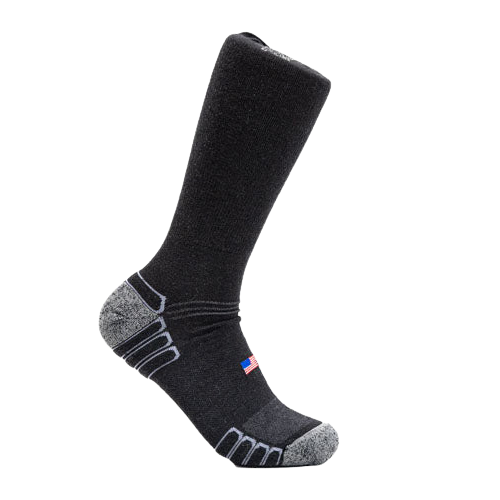Removing tar from your boots can look like an impossible job, but with a little know-how and effort, it doesn’t have to mean the end of your boots.
I recently had to check my roof for a leak and finished up with tar all over my boots, but within a day, they looked as good as new.
By the end of this article, you’ll know exactly how to remove tar from your own shoes. It doesn’t matter if it’s a thin layer or a huge chunk, I’ll show you how to deal with either scenario so you’ll not have to throw your shoes away.
What You’ll Need to Get Tar Off Your Boots
If the tar is already set, or it’s just a thin layer that needs removing, then you can start to remove it immediately using a few simple materials. A big plus is that there are several options, and you’ll usually have at least one lying around at home.
The materials you’ll need to remove the tar are:
- A sealable plastic bag
- A blunt kitchen knife or disposable plastic knife
- Warm water and dish detergent
- An old toothbrush or microfiber cloth
- Olive oil, baby oil, or petroleum jelly
- WD-40, though this shouldn’t be used on leather
How to Get Tar Off Your Work Boots
I’ve found that the best way to remove tar from your boots is to clear as much off as possible using a blunt knife.
The problem is, if the tar isn’t set, you’ll only end up spreading it over even more of your boots, so it’s better to start the process by freezing the tar to make it more solid.
If the tar is already solid, skip this step and move on to scraping off the excess tar. If not, your first step will be to freeze your boots.
1. Freezing the Tar
Step 1: Bag up Your Boots
You’re going to need to freeze the tar on your boots so that you can scrape it off easier, and the quickest and easiest way to do that is to stick your boot (or boots) into the freezer for a while.
Place your boot into a sealable plastic bag and place it in the freezer. It’s purely for hygiene that you’re bagging up your boots, although it will also prevent your boots from becoming damp, which can cause issues if they’re leather.
Step 2: Freeze the Tar
How long you leave your boots in the freezer depends on how much tar is on your boots. I’ve never had to leave mine in for more than an hour or two, but it’s easy to keep checking by simply touching the tar to see if it has hardened.
Step 3: Defrost Your Boots
Once the tar isn’t going to spread, you can remove your boots from the freezer.
You can move straight on to the next step in the process without scraping any off, but I’ve noticed that scraping off the excess tar is easy enough and speeds things up.
Using a softening agent so that your boots look completely clean seems to need repeating a lot more if the tar is thicker, as you have to take it off in layers.
I recommend letting your boots thaw until they’re at room temperature before moving on—you’ll then be able to completely remove the tar in one session.
2. Scraping off the Excess Tar
You’ll now be able to carefully scrape off as much of the tar on your boots as you can using a blunt knife. This part of the process makes it easier for you as you’re able to scrape at the tar without it spreading.
Step 1: Target Any Thick Areas
The whole point of this step is to get as close to your boots as possible, scraping off the hardened tar with a rounded knife or disposable plastic knife.
You’ll want to avoid a sharp knife as there’s a risk of marking your boots. You may need to use a little force, but target any thicker areas of tar and scrape them off as much as you can.
Step 2: Repeat until You Stop Getting Results
You’ll be very lucky to get all of the tar from your boots using this method, but that’s fine—you’re not supposed to.
Tar can be removed using a few simple household materials, and the chemical reaction will make it easier to clean your boots safely and without scratching them with a knife.
You’ve frozen and then scraped off as much tar as possible to speed up the process. The thicker the tar, the more you’ll have to repeat the next stage, so having the thinnest layer of tar to remove is in your best interests.
3. Removing the Rest of the Tar
You’ve made a lot of progress in removing the tar from your boots, but they still look a mess. It’s now time to completely remove the remaining tar, so your boots look as good as new.
You’ve got several choices when it comes to softening the remaining tar, ranging from olive oil, baby oil, petroleum jelly, dish detergent and water, and WD-40 lubricating oil.
If you’re removing tar from leather shoes or boots, I wouldn’t recommend using WD-40 as it can stain the leather.
Step 1: Apply the softening Agent
My personal preference is to use baby oil or dish detergent, as it’s less harmful to my boots. As a parent, baby oil is also something that’s already to hand whenever I need it, and who doesn’t have dishes to clean?
Using either an old toothbrush or a microfiber cloth, apply the baby oil (or your preferred choice of softener) to the areas where the tar remains. If you use a toothbrush, gently scrub the tar with oil to start softening it.
If you’re using a cloth, dab at the tar with a small blob of oil. Make sure only to target the areas where there’s tar, as you don’t want to soak your boots in oil as it can leave stains that are hard to remove.
Dish detergent and warm water makes doing the dishes much easier, and that same softening process can be used to make it easier to remove tar.
If you’re using dish detergent, simply apply it in the same way you’d apply baby oil—by targeting the tar and allowing it to soak in and soften it.
Step 2: Start Scraping Off the Soft Tar
Leave the oil to soak into the tar for around 15 minutes, and then gently scrape it away using a blunt kitchen knife or disposable plastic knife.
The baby oil or dish detergent will have soaked into the tar enough to prevent it from bonding to your boots, so you don’t have to hack at it. Using a blunt knife means you’ll be able to scrape away the layers without damaging your boots.
Wipe around the area of tar to ensure no oils seep into your boots and scrape inwards to the center of the tar. If you scrape from the center of the tar and scrape outwards, you could mark your boots.
Step 3: Repeat until Your Boots Are Clean
You may need to repeat step two again after you’ve removed most, but not all, of the tar, but the second time you’ll find it’s a lot easier as there’s less tar left, and it’s soft enough to scrub away.
At this point, I find that I can usually just use a microfiber cloth with a little oil on it and wipe away the remaining tar. If the tar still needs work, use the blunt kitchen knife to very gently scrape away the last of it.
Removing Sticky Stuff Is Easy
When you get tar on your boots, your first assumption is that they’re ruined. Walking through your (or a customer’s) home with tar on your boots is a recipe for disaster.
Carpets, rugs, and even hardwood floors will end up with black marks that can be harder to clean than your boots.
I hope this guide has shown you that removing tar from your boots is not difficult—all it takes is a little effort and time, and you’ll soon have your boots clean again.
You now know that throwing your boots away is unnecessary, as you’ll probably have everything you need at home to remove the tar easily.






